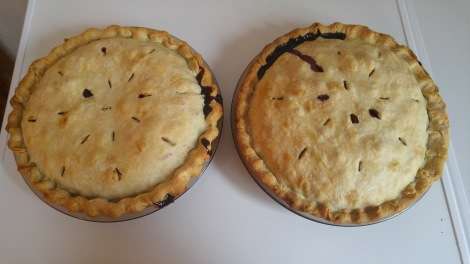The wild Maine blueberry was an underappreciated fruit for centuries until the Civil War put it on the national map.
In fact, most berries grown in the United States got short shrift from cooks, canners and anyone outside of New England.
“We do not realize how rich our country is in berries,” noted Henry David Thoreau in his lost manuscript Wild Fruits, published more than a century after his death in 1862.
Indians understood the value of wild blueberries, and managed the fields by burning them periodically to get rid of weeds and bugs. They boiled blueberry roots for tea. They dried the berries and made them into a pudding called Sautauthig (pronounced sawí-taw-teeg).
Historians believe the Pilgrims served Sautathig at the first Thanksgiving meal. In a letter, one Plimoth Plantation colonist described how to prepare Sauthauthig
…this is to be boyled or stued with a gentle fire, till it be tender, of a fitt consistence, as of Rice so boyled, into which Milke, or butter be put either with sugar or without it, it is a food very pleasant.
The Maine Blueberry Barren

Blueberry barren in fall
Wild blueberries are unique to eastern Maine, with its rocky acidic soil and cold climate. Wild blueberry fields earned the name ‘barrens’ because they grow ‘nothing other than blueberries, sweet fern, scrub birch, and willows.’
The wild blueberry is smaller and sweeter than its cousin, the high-bush blueberry. Mainers have no truck with high-bush blueberries, viewing them as ‘just wrong.’
Blueberries appeared in American cookbooks far later than other fruit. The first published use of the word “blueberry pie” may have appeared in New England Farmer in November 1829, and only in passing. The article described a cranky New England innkeeper.
A Mrs. Bliss may have published the first recipe for blueberry pie in her Practical Cook Book in 1850. It included instructions for venting the pie to help prevent juice from running out – the bane of the blueberry pie maker. Nicolo Sacco requested blueberry pie for his last meal before his execution in 1927.
Historians disagree on whether the blueberry rake – a round dustpan with teeth – was invented by Downeaster Abijah Tabbut sometime in the 19th century. Today there is only one blueberry rake maker in Maine.
New Englanders ate wild blueberries and sold them commercially, but few knew them outside the region. Then came the Civil War. Sardine canneries lost their Southern markets, so they switched to selling canned blueberries to Union troops. The soldiers developed a taste for the sweet wild berry and took it home with them after the war.
Blueberry Milestones
In 1874, Jasper Wyman started a seafood canning company in Milbridge, Maine. Twenty-five years later, he shifted to canning wild blueberries. For the next hundred years, the Wyman family bought thousands of acres of fields and blueberry barrens. The family now has 10,000 acres of blueberry barrens and freezes instead of canning the blueberry. Wyman’s today is one of six companies that process and freeze wild Maine blueberries.
Several wild Maine blueberry milestones were passed in the 20th century. Helen’s Restaurant opened in Machias, Maine, in 1950 by Larry Mugnai and his wife Helen. Helen’s wild Maine blueberry pie is consistently voted the best in Maine, if not the world.
In the 1990s, research showed wild Maine blueberries have high levels of antioxidants. They were also shown to improve memory in older rats. A new marketing strategy was born.
And in 1990, a Manchester, Maine, fifth-grader named Megan Frank persuaded the Maine Legislature to vote the wild Maine blueberry the official state berry.
This story about the Maine wild blueberry was updated in 2023. Image of blueberry barren in fall By Dennis Jarvis from Halifax, Canada – DSC_9870 – The Red Sea!!!Uploaded by X-Weinzar, CC BY-SA 2.0, https://commons.wikimedia.org/w/index.php?curid=19955204. Fresh blueberries By spurekar – Fresh blueberries, CC BY 2.0, https://commons.wikimedia.org/w/index.php?curid=96152203.




6 comments
[…] blueberries are still an excellent source of antioxidants. That’s why you want to order organic wild Maine blueberries in bulk from Blue Zee Farm. Talk to Renata Scarano about ordering some on the next Friday […]
[…] still speak their native language and own the Northeast Blueberry Corp., the third largest blueberry farm in the […]
Where did you find the information fabout the wild blueberries and the Civil War.?
[…] wanted photographed. The list included hazel nuts, marsh grass, oak leaves, pine cones, birch bark, low-bush and high-bush blueberries, red maple and speckled alder […]
[…] Pope soon would drift downward in the ranks of the military as other genrals rose up to prominence and the Civil War proceeded. […]
[…] The factories that churned out canned and bottled food for Union soldiers churned out ketchup after the Civil War, They promoted it as a sauce that stayed fresh for any length of time. In 1876, F & J Heinz introduced tomato ketchup and advertised its convenience. “Blessed relief for Mother and the other women in the household” went the ad. […]
Comments are closed.